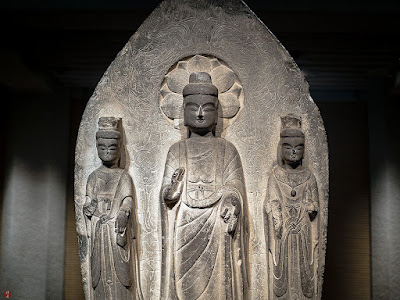Limestone
Eastern Wei dynasty, 6th century
This stone image is comprised of Shaka-Nyorai (Sakyamuni Buddha) in the center, Monju-Bosatsu (Manjusri) on the right and Fugen-Bosatsu (Samantabhadra) on the left.
The central image of this sculpture represents the Shaka-Nyorai (Buddha as the eternal saviour) preaching to all living beings, including human beings, based on his own enlightenment, in order to save those suffering from their delusions and agonies and to save their straying minds.
In Sanskrit, the word "nyorai" means one who comes from truth. Among the various forms of the Buddha, this deity is the supreme being who has attained the ultimate state of spiritual awakening.
With the later establishment of the Mahayana Buddhism, the images of Buddha other than the Shaka-Nyorai, that is Amida-Nyorai, Yakushi-Nyorai, Dainichi-Nyorai and so on, appeared as the transformations of the Buddha.
The shapes of the left and right palms of this Shaka-Nyorai symbolizes his limitless wisdom and compassion for removing fears and pains from all living being, giving them peace of mind and answering their wishes.
The Monju-Bosatsu is the bodhisattva who imparts sacred wisdom to self-deluded beings to help them attain spiritual awakening. The Fugen-Bosatsu is the deity who appears everywhere as a "bodhisattva of action" to save all living things through his wisdom and compassion. A bosatsu (Bodhisattva) is one who has reached enlightenment but vows to save all beings before becoming Shaka-Nyorai Buddha.
The lotus-petal-shaped halo represents the luminous rays of the supreme wisdom and compassion emanating from the bodies of the Shaka-Nyorai and the Bosatsus. On the surface of this limestone halo, various lotus flowers, numerous transformations of Buddha, the Hiten (heavenly beings) who are flying and performing music around Buddha are beautifully engraved.

No comments:
Post a Comment